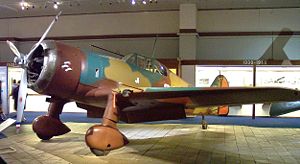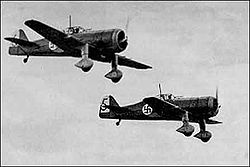Fokker D.XXI Video - Picture

|
|
Fokker D.XXI
D.XXI

Role: Fighter
Manufacturer: Fokker
Designed by: Erich Schatzki
First flight: 27 March 1936
Primary users: Finnish Air Force
Dutch Air Force
Danish Air Force
The Fokker D.XXI fighter was designed in 1935 for use by the Royal Netherlands East Indies Army Air Force (Militaire Luchtvaart van het Koninklijk Nederlands-Indisch Leger, ML-KNIL) . As such, it was designed as a cheap and small, but rugged aircraft, which had respectable performance for its time. Entering operational use in the early years of World War II, it provided yeoman service for both the Luchtvaartafdeling (Dutch Army Aviation Group) and the Finnish Air Force, and a few were built by the Carmoli factory before the factory fell into Nationalist hands during the Spanish Civil War.
Design and development
The Fokker D.XXI was a low wing monoplane with a steel tube fuselage covered in large part by fabric. Following some of the standard Fokker design practice, it had wooden wings and a fixed spatted undercarriage. Power was provided by a Bristol Mercury radial driving a three-blade two-pitch airscrew. When it entered service in 1938 it was a quantum leap forward for the Dutch Army Aviation Group though. Until then its fighter force had consisted of aging biplanes with open cockpits. The new Fokker proved to be an extremely sturdy aircraft capable of attaining a speed of 700 km/h in a dive.

Picture - Fokker D.XXI aircraft in the Finnish air force during World War II
Operational history
In 1936 a few Fokker D.XXIs were used by the Spanish Republic. Although the order by the ML-KNIL was cancelled, the Luchtvaartafdeeling (Dutch Army Air Force before World War II) placed an order of 36 aircraft, which were all delivered in time to participate in the war against the Germans in May 1940. The Fokker D.XXI, although much slower and more lightly armed than the Bf 109, performed surprisingly well in dogfights, due to its maneuverability. It was also one of the few aircraft that could follow a Stuka bomber into its dive. Nonetheless, the numerical inferiority of the Luchtvaartafdeeling compared to the Luftwaffe resulted in the destruction of most Dutch Fokker D.XXI fighters during the campaign. Some were captured during and after 15 May, but their fates, apart from their capture, are unknown.
The Fokker D.XXI performed better and for much longer in the Finnish Air Force, which had acquired a number of licence-built fighters prior to the start of the Winter War. Against the aircraft of the Soviet Air Force, the Fokker was more evenly matched, and its rugged design with a radial engine and fixed undercarriage made it very suitable for Finnish conditions. Later in the war, as newer models of Soviet fighters appeared, the Fokker D.XXI was underpowered and too lightly armed (with only four 7.92 mm/.312 in machine guns) to compete. Plans to arm the Fokkers with 20 mm cannons were dropped and only one fighter was armed as such (two 20 mm cannons and two 7.92 mm/.312 in machine guns). Another fighter was equipped with retractable landing gear, but due to less than anticipated performance improvement, wasn't continued in the series. During the Continuation War (1941-44) the Finnish State Aircraft Factory (Valtion Lentokonetehdas, VL) also built some 50 D.XXIs with the Swedish-built Pratt & Whitney R-1535 Twin Wasp Junior as the Bristol Mercury was in short supply. These can be identified by their longer cockpit glazing, smooth cowl, and large ventral air intake under the cowl. The fixed undercarriage lent itself to both unimproved runways and conversion to skis for winter use, both of which were advantages in the Finnish theater.
Several Finnish Air Force pilots became fighter aces on Fokker D.XXI, top scoring Fokker ace being Jorma Sarvanto with 12 5/6 victories. Many other aces scored at least one victory on Fokker. The highest scoring airframe is FK-110, with 10 victories, which survived the war, and is on display at Central Finland Aviation Museum.
Variants
D.XXI-1 : First production aircraft, they were delivered to Denmark. Number built: 2
D.XXI-2 : 36 were delivered to the RNLAF. Number built: 53
D.XXI-3 : Finnish license-built D.XXI-2s. Number built: 38
D.XXI-4 : Upgraded D.XXI-3, powered by R-1535-SB4C-G Twin Wasp Junior engine 825 hp (615 kW). Number built: 50
D.XXI-5 : Upgraded D.XXI-4, powered by Bristol Pegasus radial engine 920 hp (686 kW). Number built: 5
Project 150 : Proposed version powered by a Bristol Hercules radial piston engine. Not built.
Project 151 : Proposed version powered by a Rolls-Royce Merlin piston engine. Not built.
Project 152 : Proposed version powered by a Daimler-Benz DB.600H engine. Not built.
Operators
Denmark
Danish Army Air Corps received 7 aircraft and built 15 on license.
Finland
Finnish Air Force received 7 aircraft and built 90 on license.
No. 10 Squadron, Finnish Air Force
No. 12 Squadron, Finnish Air Force
No. 14 Squadron, Finnish Air Force
No. 24 Squadron, Finnish Air Force
No. 26 Squadron, Finnish Air Force
No. 30 Squadron, Finnish Air Force
No. 32 Squadron, Finnish Air Force
Germany
Luftwaffe operated an unknown number of captured Dutch aircraft.
Netherlands
Dutch Army Aviation Group received 36 aircraft.
1 Luchtvaartregiment (1 aviation regiment) 1 and 2 Jachtvliegersafdeling (JaVa) (fighter squadron) 2 Luchtvaartregiment
Spanish Republic
Spanish Republican Air Force
Popular culture
A converted North American Harvard trainer masqueraded as a Fokker D.XXI for the Paul Verhoeven movie Soldier of Orange (1977).
Specifications (D.XXI)
Data from Lentx¤jx¤n Nx¤kx¶kulma & Thulinista Hornetiin
General characteristics
Crew: One, pilot
Length: 8.20 m (26 ft 11 in)
Wingspan: 11.00 m (36 ft 1 in)
Height: 2.95 m (9 ft 8 in)
Empty weight: 1,594 kg (3,511 lb)
Max takeoff weight: 1,970 kg (4,399 lb)
Powerplant: 1x— Bristol Mercury VIII air-cooled, 9-cylinder, radial, 618.76 kW (830 hp)
Performance
Never exceed speed: 700 km/h (434 mph)
Maximum speed: 460 km/h (285 mph)
Cruise speed: 429 km/h (267 mph)
Range: 930 km (502 nmi, 574 mi)
Service ceiling: 11,350 m (36.089 ft)
Rate of climb: 6,000 m in 7 min 30 sec (19,680 ft)
Power/mass: 405 hp/t ()
Armament
4 x— 7.92 mm (.312 in) FN Browning M36 machine guns
Comparable aircraft
Curtiss Hawk 75
Nakajima Ki-27
Koolhoven F.K.58
Bibliography
De Jong, Peter. Le Fokker D.21 (Collection Profils Avions 9) (in French). Outreau, France: x‰ditions Lela Presse, 2005. ISBN 2-914017-26-X.
Eberspacher, Warren. Fokker D-XXI, Volume 1: Dutch and Danish Aircraft (International Squadron Monograph No.1). St. Paul, MN: Phalanx Publishing Co. Ltd., 1994. ISBN 1-883809-05-3.
Gerdessen, Frits. Nederlandse Militaire Luchtvaartt VI: Fokker D-XXI (deel 2) (in Dutch). Spijkenisse, the Netherlands: Stichting Vrienden van het Militaire Luchtvaart Museum/Afdeling Luchtvaartkennis KNVvL, 1991. No ISBN.
Gerdessen, Frits and Luuk Boerman. Fokker D.XXI: History, Camouflage and Markings - Operations of the LVA/ML Fokker D.XXI (Dutch Profile 5) (bilingual Dutch/English). Zwammerdam, the Netherlands: Dutch Decal, 2007. No ISBN.
Green, William. "D-XXI: Ancestor of Alliance". RAF Flying Review Vol. XVII, No. 12.
Green, William. "Four Guns and a Canopy". RAF Flying Review, Vol. 19, No. 2.
Green, William. "The 'Halfway-House' Fokker". Air Enthusiast, August 1971.
Green, William. "The Last of the Fighting Fokkers". RAF Flying Review.
Green, William. Warplanes of the Second World War, Volume One: Fighters. London: Macdonald & Co. (Publishers) Ltd., 1960 (tenth impression 1972). ISBN 0-356-01445-2.
Green, William. Warplanes of the Second World War, Volume Three: Fighters. London: Macdonald & Co. (Publishers) Ltd., 1961 (Seventh impression 1973). ISBN 0-356-01447-9.
Heinonen, Timo. Thulinista Hornetiin - 75 vuotta Suomen ilmavoimien lentokoneita (in Finnish). Tikkakoski, Keski-Suomi, Finland : Keski-Suomen ilmailumuseo, 1992, ISBN 951-95688-2-4.
Hooftman, Hugo. Fokker D-XXI (Nederlandse Vliegtuig Encyclopedie 5) (in Dutch). Bennekom, the Netherlands: Cockpit-Uitgeverij, 1978.
Kamphuis, G.H. The Fokker D.XXI (Aircraft in Profile number 63). Leatherhead, Surrey, UK: Profile Publications Ltd., 1966.
Keskinen, Kalevi, Kari Stenman and Klaus Niska. Fokker D.XXI (Suomen Ilmavoimien Historia 3) (in Finnish, with English summary) . Espoo, Finland: Tietoteos, 1974 (2nd edition 1977). ISBN 951-9035-15-X.
4th improved edition republished in two parts as:
Keskinen, Kalevi and Kari Stenman. Fokker D.XXI [Mercury] (Suomen Ilmavoimien Historia 3a) (in Finnish). Helsinki, Finland: Hobby Kustannus Oy, 2000. ISBN 952-5334-02-3.
Keskinen, Kalevi and Kari Stenman. Fokker D.XXI [Wasp] (Suomen Ilmavoimien Historia 3b) (in Finnish). Helsinki, Finland: Hobby Kustannus Oy, 2000. ISBN 952-5334-03-1.
Ledwoch, Janusz. Fokker D.XXI (Wydawnictwo Militaria 5) (in Polish). Warsawa, Poland: Wydawnictwo Militaria, 1995. ISBN 83-86209-34-8.
Raunio, Jukka. Lentx¤jx¤n nx¤kx¶kulma 2 (in Finnish). Forssa, Finland, 1993. ISBN 951-96866-0-6.
Skulski, Przemysław. Fokker D.21 (Seria "Pod Lupą" 10) (in Polish, with English summary). Wrocław, Poland: Ace Publication, 1999. ISBN 83-86153-79-2.
Taylor, John W.R. "Fokker D.XXI" Combat Aircraft of the World from 1909 to the present. New York: G.P. Putnam's Sons, 1969. ISBN 0-425-03633-2.
Toll, Karl. "The Last of the Fighting Fokkers". Airpower, January 1982.
Fokker D.XXI Pictures
More aircraft.
Source: WikiPedia